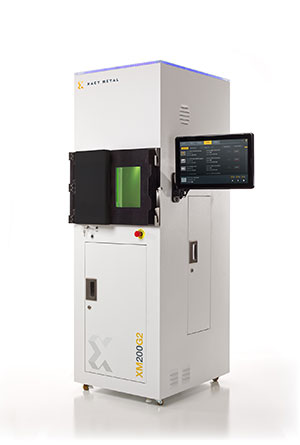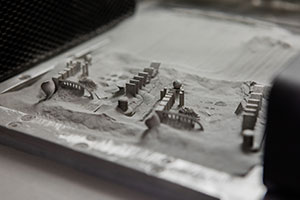Metal 3D printing allows companies to design outside of traditional manufacturing constraints. This gives engineers the opportunity to improve part performance by making lighter parts, for example. Despite this advantage amongst others, the manufacturing industry has been slow to adopt this technology. One of the main reasons for this is the cost of metal 3D printing.
As a newer technology, metal 3D printers tend to have a higher associated up-front cost compared to their plastic counterparts. Scott Kraemer, an application engineer at metal 3D printing company Xact Metal, believes cost is the biggest barrier for small- and medium-sized manufacturers looking to adopt metal 3D printing.
“The cost to bring a machine in-house is an initial barrier for lots of smaller companies,” Kraemer said. “Then once you get it in-house, you’ve got to put it in a controlled environment and then train people on how to use it, and there’s cost associated with all of that.”
Though cost has been a major deterrer for the adoption of metal 3D printers, this technology has several applications and benefits. From dental to defense and automotive to tooling, there are a number of different industries leveraging metal 3D printing. The aerospace industry is probably the largest adopter of this technology, suspects Kraemer.
“When it comes to aerospace you hear about lightweighting, because the more weight you have, the more it costs to fly,” Kraemer explains. “So, aerospace uses metal 3D printers to involve lattice structures and generative designs, reducing mass, which makes it easier to fly for both aircraft and rockets.”
Some additional applications for metal 3D printers include rocket engines, titanium implants in the human body, and electric vehicle components. Kraemer says that lightweighting is a main benefit for these industries and has driven a lot of adoption for metal 3D printers.
“More and more companies are starting to adopt, but it’s still slow moving,” Kraemer adds. “Driving adoption is all about getting companies to realize that one is not going to replace the other. Metal additive is not going to replace traditional manufacturing, but it’s another tool in your toolbox to make a component, and often make it more effective than otherwise possible.”
The focus of Xact Metal is to make metal 3D printing more accessible for companies, and Kraemer knows that education is the key to this initiative. He says lots of younger students graduating high school and college know 3D printing and have the mindset to design for it. The challenge is sharing this knowledge with older generations to get the technology more widely adopted.
Kraemer highlights a recent situation he saw that showcases this generational divide: “I was at a customer recently, and a good portion of their machining staff is 60+ years old and they don’t like the idea of new technology. They don’t want to adopt something new. But you’ve got a lot of these people coming out of college and high school that already know how to 3D print. So, it’s going to take a little bit of a marriage of the older generation and younger generation to drive adoption in the industry.”
Once manufacturers and machinists realize metal 3D printing is a tool they can use alongside traditional manufacturing methods, Kraemer said adoption will start to grow. Cost is also something Xact Metal works to combat by making more affordable metal 3D printing technologies.
“We’ve made a machine that just about any company or small business can afford, therefore making the barrier of entry much lower. What we’re doing is easily affordable, it’s adaptable, and it’s easy to work on and use. There are so many things this machine can do at an affordable price-point, it’s almost like a ‘Why not?’ at this point to adopt it,” says Kraemer.
“We’re printing parts right now for mold inserts probably at half the cost of what it would be for traditional methods,” Kraemer adds. “If we can make these parts cheaper than you could with conventional technology, then adoption is going to be even better and quicker.”
Manufacturers are already using metal 3D printing for production parts, but to spur widespread adoption there needs to be more education around the technology. Kraemer cites discussions at RAPID + TCT and other additive events as a primary method to educate people about metal 3D printing and the need to design for additive.
“The more we can educate people and educate the industry that they have to design for the process, the more companies are going to be able to adopt and grow with additive technologies,” Kraemer says. “We’re on the verge. With reshoring activities and the younger generation’s interest in 3D printing, the perfect storm is developing that’s going to drive adoption of additive here in America and it’s exciting to see.”
Metal 3D printing has made manufacturers think differently about how parts can be made. Companies like Xact Metal are helping small- and medium-sized companies overcome barriers such as high costs and lack of knowledge to drive adoption of this technology. For more information on metal 3D printers, consider reaching out to Xact Metal. You can also attend RAPID + TCT to meet with 3D printing companies and learn about advances in additive manufacturing.
Bio:
Scott Kraemer, Application Engineer at Xact Metal
With an impressive 32-year career spanning roles as a Directing Manager, Tooling Engineer, Application Engineer, and Mold Designer, Scott Kraemer has excelled in the development of complex injection multi-shot molds, tooling, and products across industries, including medical, automotive, and consumer goods. Over the past 12 years, Scott has been a trailblazer in the incorporation of additive manufacturing (3D printing) for both plastic and metal into mainstream production parts and tooling. A passion for educating others about opportunities within the manufacturing industry led Scott to create the PTI Technical Academy program, which gained approval from the State of Michigan. This program provides high school students with hands-on training and showcases various career paths within the Plastic Injection Molding Industry. As of 2023 Scott has begun work with Xact Metal, a metal 3D printer manufacturer that shares his goal of integrating additive manufacturing technology into mainstream production and tooling.
